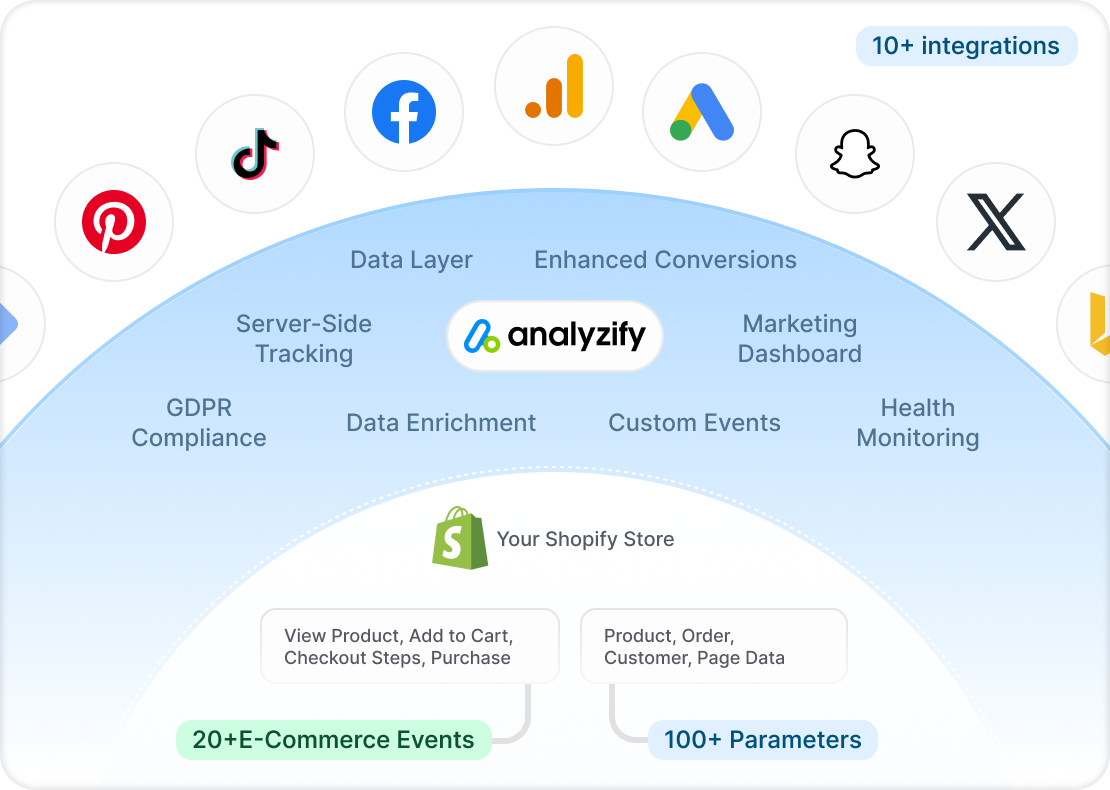Google’s Warning on Shopify Custom Pixels: What It Means for Your Store
In recent weeks, many Shopify merchants received warning emails from Google urging them to migrate their tags:
“Update Google tag setup on Shopify to avoid disruption”.
That was followed by Shopify banners saying:
“Migrate your Google tags to Google & YouTube app to avoid data loss and service disruption.”
You’ve likely read our first blog post about it, where we explained why you shouldn’t worry about “Update Google Tag Setup on Shopify to Avoid Disruption” if you’re using Analyzify.
However, along with those warning emails, Google shared some documentation regarding Shopify’s Custom Pixel feature. Specifically, Google stated:
“Running Google tags inside Shopify’s custom pixel feature is not a supported implementation. Due to limitations of this environment, Google cannot guarantee the behavior of Google tags that are implemented using a custom pixel.”
We’ve since received follow-up questions from our clients, especially those who saw this warning and were unsure how it might affect their setup.
In this post, you’ll learn:
- What Google’s recent statements about Shopify’s Custom Pixel feature mean
- How these statements may affect different types of tracking implementations
- Why Analyzify’s hybrid tracking architecture is uniquely built for Shopify’s environment
- Analyzify’s approach to combine multiple methods for full data reliability
- Why Analyzify users can remain confident: your setup already covers it all
Let’s get started!
Running Google Tags Inside Shopify’s Custom Pixel Feature: What’s Wrong?
Custom pixels were introduced by Shopify as part of the Web Pixels API.
It’s an official method for apps like Analyzify to send events from storefront pages. However, Google’s document about tag migration suggests that they can’t guarantee full compatibility or data reliability when their tags are implemented through this method.
That does not mean Custom Pixels are broken.
It means that Google doesn’t offer official support if issues arise from that environment.
If an issue occurs, such as incomplete data or tracking inconsistencies, disrupted or unstructured parameter values, Google may not assist in troubleshooting.
That said, this warning is primarily for merchants using single-layer or DIY implementations.
For more advanced tools like Analyzify, Custom Pixels are just one part of a larger, more robust tracking system.
How Analyzify Goes Beyond Custom Pixel Limitations
![]()
Analyzify uses Shopify’s Custom Pixels feature - but not as a standalone solution.
With Analyzify, you get a hybrid tracking system that blends multiple tracking approaches for better coverage and full data reliability:
- Client-Side Tracking for all important behavioral events
- Server-Side Tracking - with 98% purchase tracking accuracy in GA4
- App Embed scripts for broader event collection
- Checkout-specific tracking scoped properly for different page types
What really sets Analyzify apart is how these layers talk to each other.
We’re not just duplicating events - we’re cross-validating them. If one method encounters a limitation (as Custom Pixels sometimes do), the others provide a fallback.
This ensures your event data is complete, reliable, and not dependent on a single method or environment.
In other words: Google may not support Custom Pixels as a standalone solution - but Analyzify doesn’t rely on them alone, and that makes all the difference.
Analyzify’s Multi-Layered Approach to Shopify Data Tracking

Analyzify is carefully designed to provide reliable e-commerce tracking & data, capable of covering every update in Shopify’s tracking environment.
Here’s how it works under the hood:
- Multiple tracking channels:
We implement several mechanisms—custom pixels, app embed scripts, and scoped storefront-checkout integrations. Each of these serves a specific purpose and complements the others. - Smart scope handling
Shopify’s storefront and checkout operate in different environments with different rules. We treat these scopes independently, applying custom logic and parameters depending on the context. - Real-time validation and switching
We continuously monitor the accuracy of each layer. If one method becomes less reliable in a specific store or scenario (e.g. due to browser restrictions or Shopify changes), our system can prioritize the more accurate channel—without requiring you to make changes. - Unified dataLayer structure
All events - regardless of where they originate - are pushed into a unified data layer. This structure ensures consistency and reliability when passed to platforms like Google Analytics 4, Google Ads, Meta, or TikTok via GTM. - Seamless fallback logic
For example, if a browser blocks third-party cookies or disables scripts that affect the pixel layer, our server-side tracking continues to deliver key events like purchases and checkouts, preserving attribution integrity.
This engineering approach means Analyzify isn’t just compatible with Shopify - it’s purpose-built for it.
By covering every layer of the tracking ecosystem, we ensure your marketing data remains accurate, actionable, and protected from the platform-level changes or technical limitations.
From hybrid tracking to future-proof integrations and professional setup, we’ve got your Shopify data analytics covered - so you can focus on scaling your store with confidence.
 Professional Implementation & Migration Included
Professional Implementation & Migration Included Set up future-proof e-commerce tracking with Analyzify
Let Analyzify improve your tracking so you can trust your data and make confident decisions.E-commerce Tracking is Evolving - and Analyzify is Ready for It
Shopify, Google, Meta, and TikTok are all evolving rapidly.
Tracking setups that worked a year ago may now be deprecated or cause data loss.
That’s why Analyzify stays ahead of these changes - testing new approaches, implementing hybrid systems, and keeping our users informed and protected.
If you’re unsure about your current tracking setup, install Analyzify or book a demo call to see how things work. Also, feel free to reach out to our support team.
We’re here to help ensure your tracking remains accurate, future-proof, and fully compliant.
































